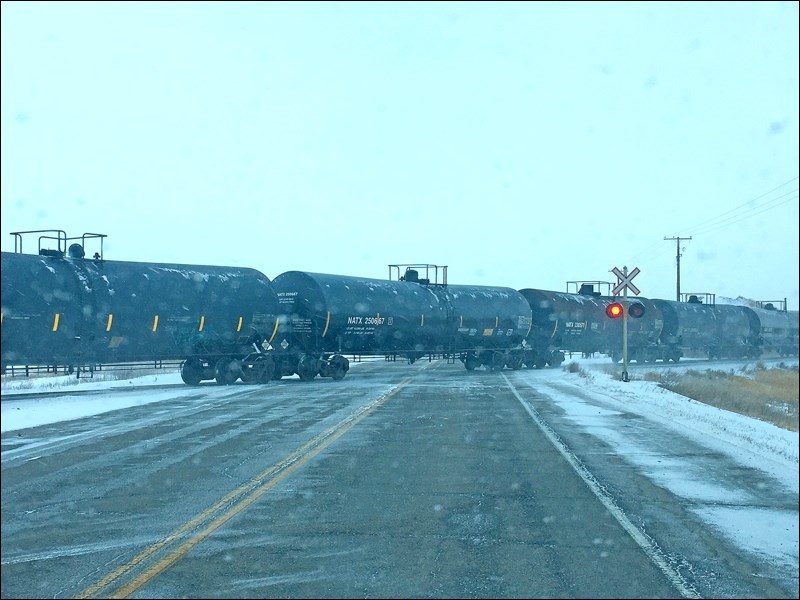I had a chilling realization on Dec. 11, two days after the crude-by-rail derailment occurred near Guernsey.
Depending on which route that train would have taken, three or so hours later, it could have passed within about 40 yards of my parents’ house on the edge of Yorkton.
It’s not that crude-by-rail trains don’t pass by regularly. But it’s especially chilling to realize that this one could have taken that route, and whatever caused it to derail could have potentially happened in Yorkton, instead.
The train started at a Rosyth, Alta., immediately east of the Hardisty oil terminal, the principle oil hub for Canada. There we find the Gibson Energy/USD Group joint venture crude-by-rail loading facility. Its destination was Stroud, Okla. – a chilling coincidence as that’s my stepdad and mom’s last name. Stroud is right beside Cushing, Okla., which is the principal oil hub for the United States.
The Transportation Safety Board update I received that evening did not indicate which route the train would have taken to Oklahoma. According to CP’s route map available on its website, from Guernsey it could have gone south to Regina, Moose Jaw and Estevan, down to Minneapolis, or it could have continued eastward through Yorkton to Winnipeg, and south to North Dakota. Either route would have had it eventually on the Soo Line to Minneapolis. CP’s mainline network ends at Kansas City, which would have then required a different rail company to take the train to Stroud.
The origin and destination of this train essentially mirror the origin and ultimate destination of the proposed Keystone XL pipeline, although the terminus for that pipeline would be Steele City, Neb. There it would join the Cushing Extension, which runs from Steele City to Cushing.
Let me put that another way: If the Keystone XL pipeline had been built by now, this oil likely never would have been in a rail car. And that rail car would have never potentially rolled within spitting distance of my parents’ house.
Not every derailment results in the contents spilling and going FOOMP. I’ve been to two already – one near Glen Ewen (Canadian Pacific), and another south of St. Lazare, Man. (Canadian National). Neither had a fire. The respective rail companies responded with remarkable speed, having the trains cleaned up, the tracks cleared and put back into service, and the spill mopped up in astounding time.
But sometimes, they do go FOOMP. This happened at Lac-Mégantic, Que., in July, 2013, and Casselton, N.Dak., in December of that same year. As we all know, Lac Mégantic is one of the worst disasters to strike Canada in this century, killing 47 people in a conflagration that can only be best described as hellfire on earth. No one was hurt at Casselton.
Following Lac-Mégantic, Transport Canada brought in new rules stiffening the safety requirements for the rail tankers used to haul crude-by-rail. According to the Transportation Safety Board, the cars that derailed were a mix of nine Class 117R and 24 CPC-1232 Class 111 tank cars. Apparently, they met the current requirements.
And yet they still spilled and burned. Thank God the people who lived close enough to see the end of their driveway in flames were not injured. I won’t say “unharmed,” because who knows what the smoke did to their lungs, or those of the first responders and the crews who cleaned up the mess while it was still burning.
We are not going to know for a very long time what caused this derailment. The Transportation Safety Board told me 600 days is their target. We still haven’t heard anything definitive about the St. Lazare, Man. on Feb. 16 of this year.
We don’t know if it was the fault of the train, which could have imperiled my parents, or anyone within the core of Saskatoon through which it passed hours earlier. We don’t know if it was the fault of the track, either. Someone I know emailed me saying they saw a maintenance crew working not far down the line, about 12 hours before the derailment. Could there be a connection? If so, is it the (bad) luck of the draw that it was crude oil that spilled, and not potash?
This is the situation we are forced into. In recent days I’ve taken to correcting several people who say we don’t have pipelines. No, we don’t have sufficient pipelines to handle additional growth of production for most of Western Canada. But we certainly do have pipelines. I worked on building a few of them.
When Enbridge’s Line 3 Replacement, finished in Canada, gets completed in the U.S., hopefully that will alleviate some of the strain. If TC Energy’s Keystone XL ever gets built, that would have almost certainly dealt with this particular cargo that spilled and burned. But even Donald Trump, who approved it in his first week in office, and subsequently reapproved it, hasn’t gotten it built. Next year he’ll be running for re-election, and still, no pipe.
I don’t know how many times it needs to be said, but oil needs to go in the pipe, and grain on the train.
Brian Zinchuk is editor of Pipeline News. He can be reached at [email protected].




